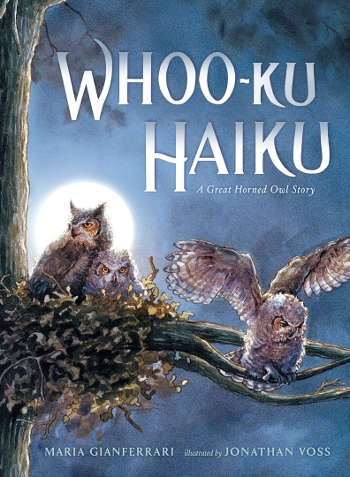I often say that a nonfiction picture book for children is the best introduction to a new subject for readers of any age, especially when the illustrations are as richly informative as the text, and that is true about great horned owls and Maria Gianferrari’s Whoo-Ku Haiku: A Great Horned Owl Story, with illustrations by Jonathan Voss.
 I often say that a nonfiction picture book for children is the best introduction to a new subject for readers of any age, especially when the illustrations are as richly informative as the text, and that is true for me about great horned owls and Maria Gianferrari’s Whoo-Ku Haiku: A Great Horned Owl Story, with illustrations by Jonathan Voss.
I often say that a nonfiction picture book for children is the best introduction to a new subject for readers of any age, especially when the illustrations are as richly informative as the text, and that is true for me about great horned owls and Maria Gianferrari’s Whoo-Ku Haiku: A Great Horned Owl Story, with illustrations by Jonathan Voss.
I first encountered this picture book months ago as a collection of haiku poems, filled with factual detail and lyrical description. I was impressed with how much a reader could learn about great horned owls, their habits, and their life cycle in just twenty-four haiku poems and through the author’s evocative use of language (e.g., “Owl family huddles-cuddles”). Now, with the Calling Caldecott challenge, I dug deeper to consider the role that the illustrations play in conveying essential information, as well as in creating a dramatic account of an owl couple and their growing family.
First, a bit of background: illustrator Voss provides fourteen double-page spreads to tell the story of a couple of great horned owls (“mama” and “papa”), who find a nest, defend it from crows, lay eggs, hatch owlets, nurture and defend their owlets, and watch as the owlets grow and prepare to leave the nest. I appreciated that he also offers additional new art for the front and back cover and title page (in addition to the interior illustrations), helping to expand the story even further. Half the time the text is placed strategically on the page within the illustration, and half the time the text appears inside a half-page column on the left or right side. The reader gets a bonus when there’s a column with text, because an additional illustration is placed there to help advance the story. For example, on one spread, the illustration in the side column shows mama owl using her “umbrella of wings” to keep her owlets “safe and warm and snug”; the larger double-page illustration shows mama owl waiting high on tree a branch and the owlets in the nest on a branch below her, while papa flies home bringing a skunk for supper. (And young readers are sure to enjoy seeing an owl fly with a skunk in its talons!)
I appreciated that Gianferrari included two pages of back matter that offers more information, if you “want to know more about great horned owls.” With clever subtitles—like “NO NEED TO CHEW!”—she provides even more fascinating details about great horned owls and their characteristics. For example, did you know that they don’t have horns at all? They have feathers or “ear tufts” that look like horns. And their eyes are so enormous (to the scale of their bodies), that if we had eyes like theirs, “they’d be as big as grapefruits!” Reference books are also cited, as well as websites and videos, and I just had to look up Cornell Lab’s “All About Birds” website and their live cams. As I investigated these resources and then returned to considering the illustrations, I saw how Voss had incorporated so many of these specific features into the art, such as the yellow eyes of the great horned owls; the borrowed nests; their predatory nature and varied diet; their “mantling” or “holding out their wings like a cloak”; the typical number of eggs in a nest (one to five); and even the different kinds of feathers on their bodies (flat on their faces, fringe feathers on their wings, etc.). I really appreciate a picture book that takes its science so seriously.
It’s also satisfying to consider the artistry in the illustrations alongside the scientific detail. Voss uses perspective effectively in taking the reader’s eye up and down—to owl-level, down to the ground looking up as an egg falls out of the nest, then at eye level with mama owl, then out a distance to survey the forest scene as a fox enters the picture. It helps create a sense of movement as the owls come and go and as the reader wonders what will happen next. Voss also employs light and dark to evoke the passing of the seasons, as well as the daylight and moonlight of morning and evening. As light shines on the owls and owlets themselves, the art reveals details of their feathers, beaks, and eyes that heighten interest and convey naturalistic attributes. The sunlight streaming through the leaves of the trees as an owlet is “trying out her wings” is particularly stunning. A short note on the copyright page tells us that the illustrations were created "using sepia ink and watercolor on Arches 300# hot press watercolor paper. Color was added digitally.” I always appreciate it when the illustrator gives us a bit of background on the creation of the art and, in this case, I’m intrigued that the art was all painted and drawn but that the color was added digitally. Voss’s palette is firmly grounded in the hues of nature dominated by greens and browns, depicting a dense landscape. His illustrations remind me somewhat of the expressive landscapes of British painter J. M. W. Turner, all imaginative and turbulent.
[Read the Horn Book Magazine review of Whoo-Ku Haiku]
Whoo-Ku Haiku is a lovely blending of poetry, science, and nature. It takes a bit of exploration and study to unpack all the meaning and subtlety on each page, but it’s worth the effort. The illustrations that feature high-adventure moments are sure to engross young readers, such as the spread that shows the owl egg falling out of the nest, down, down, down to the ground below, and another spread that shows the intervention of mama owl when the fox attacks her owlet. The haiku poems function in tandem with the illustrations as powerful captioning to the unfolding story and lend themselves to dramatic reading and performance. This is not your typical poetry book, nor your typical nonfiction picture book, but as you peel back the layers, you’ll find a glimpse into nature that is both a comforting family story and a fascinating life cycle adventure.

ALREADY A SUBSCRIBER? LOG IN
We are currently offering this content for free. Sign up now to activate your personal profile, where you can save articles for future viewing.








Add Comment :-
Comment Policy:
Comment should not be empty !!!
Declan Boyer
I believe this story is similar to Chapter Six from “Charlotte’s Web”, in which a bird couple lose an unhatched egg to a pesky mammal (a raccoon, it is). Since it is possible that the author (Maria Gianferrari) read “Charlotte’s Web” growing up, she came up with the idea for this story, in which the owls are like the geese and the pesky raccoon is like Templeton the rat.Posted : Feb 02, 2024 03:17
Virginia Rinkel
Wow, Sylvia Vardell, you have said it best! These illustrations are stunning and offer so many areas of intertwining of an owl family and the specialty of how the non-fiction and the poetry mingle also. I have followed both of these wonderful people (the author and the illustrator) and their books and this is one of the best. Thank you for your in depth take on this new book.Posted : Oct 26, 2020 01:50